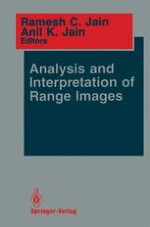1990 | OriginalPaper | Buchkapitel
Segmentation versus object representation — are they separable?
verfasst von : Ruzena Bajcsy, Franc Solina, Alok Gupta
Erschienen in: Analysis and Interpretation of Range Images
Verlag: Springer New York
Enthalten in: Professional Book Archive
Aktivieren Sie unsere intelligente Suche, um passende Fachinhalte oder Patente zu finden.
Wählen Sie Textabschnitte aus um mit Künstlicher Intelligenz passenden Patente zu finden. powered by
Markieren Sie Textabschnitte, um KI-gestützt weitere passende Inhalte zu finden. powered by
When vision is used for moving through the environment, for manipulating or for recognizing objects, it has to simplify the visual input to the level that is required for the specific task. To simplify means to partition images into entities that correspond to individual regions, objects and parts in the real world and to describe those entities only in detail sufficient for performing a required task. For visual discrimination, shape is probably the most important property. After all, line drawings of scenes and objects are usually sufficient for description and subsequent recognition. In computer vision literature this partitioning of images and description of individual parts is called segmentation and shape representation. Segmentation and shape representation appear to be distinct problems and are treated as such in most computer vision systems. In this paper we try to disperse this notion and show that there is no clear division between segmentation and shape representation. Solving any one of those two problems separately is very difficult. On the other hand, if any one of the two problems is solved first, the other one becomes much easier. For example, if the image is correctly divided into parts, the subsequent shape description of those parts gets easier. The opposite is also true when the shapes of parts are known, the partitioning of the image gets simpler.
